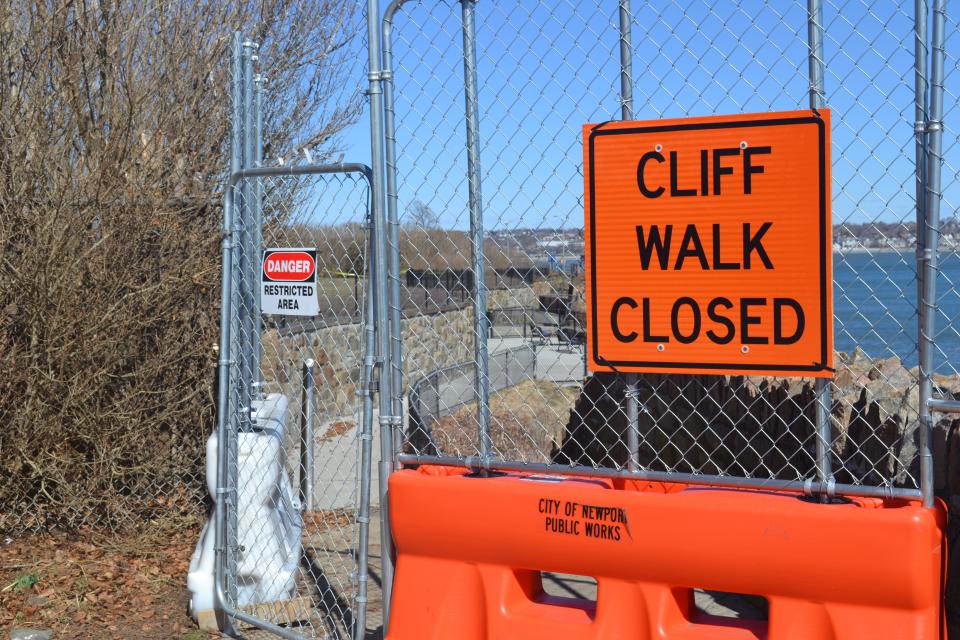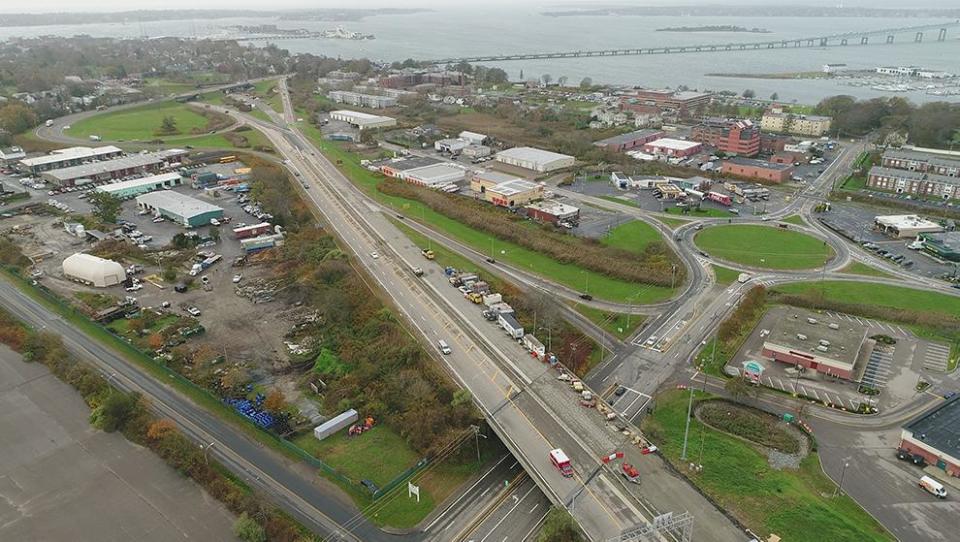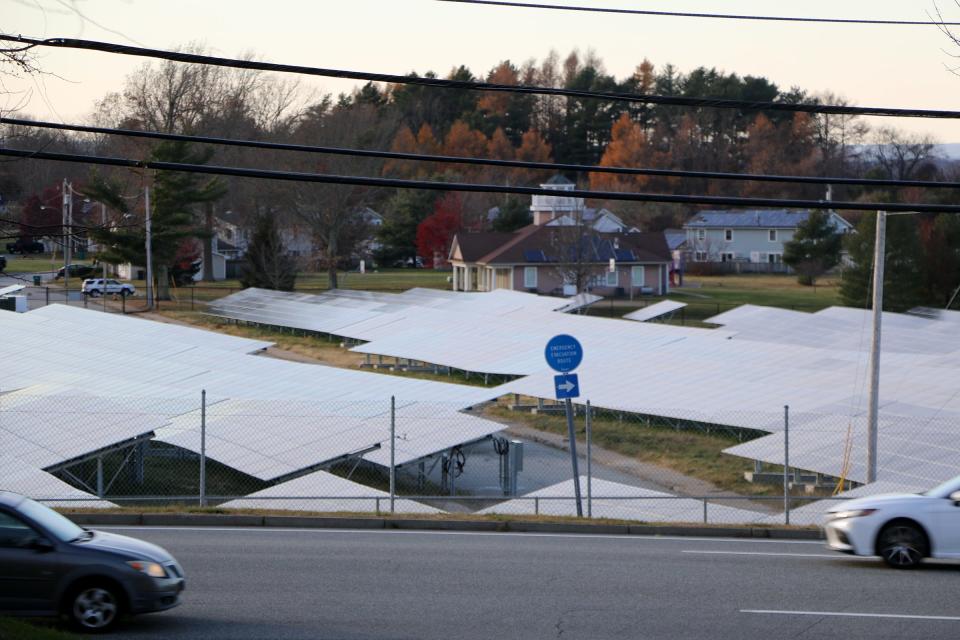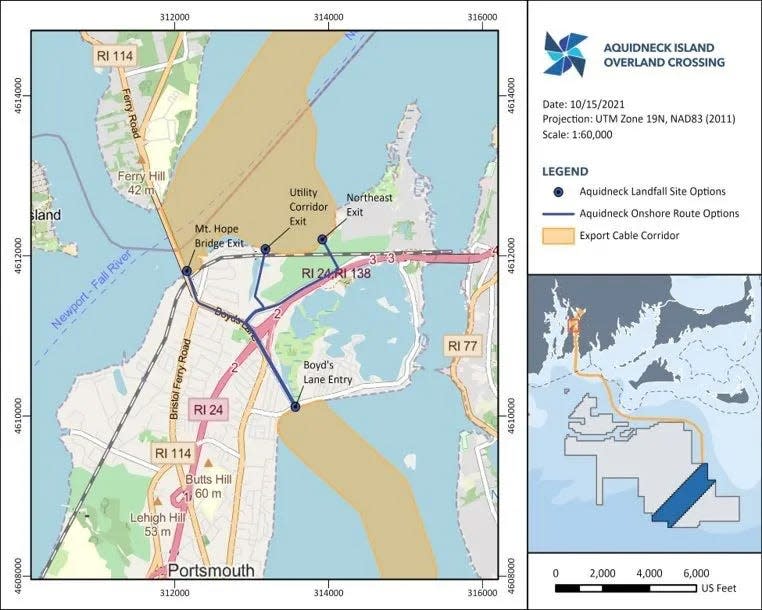Looking ahead to 2023: 10 Newport County stories to keep an eye on
There's never a shortage of news and not every story can be predicted, but we've decided to look into the future to offer a look into some stories that we expect to be reporting on in 2023.
From the future of the Cliff Walk to regionalization, we expect there will be plenty to talk about during the next 12 months.
Cliff Walk
In March, a section of Newport’s iconic Cliff Walk collapsed into the ocean, leading to the trail’s partial closure just months before the start of Newport’s tourism season. The city launched an investigation into the incident, hiring geoengineers to study the area and determine the cause before going in for repairs.

Few updates have surfaced since the investigation was launched and the Cliff Walk Commission's monthly agenda has frequently noted there were no updates to be noted. The section still remains closed and in disrepair with users asked to follow a detour. Mayor Xay Khamsyvoravong addressed the issue in an interview with WPRI earlier this month, saying the study of the area is still underway and the city might request state assistance once the study is over to aid in repair work.
North End Development
Progress to realign the ramps coming off Pell Bridge into Newport is expected to continue through 2023. The $85.5 million project, which began construction in 2020, will remove the ramp heading toward downtown Newport and remove the “highway to nowhere,” the abandoned northbound approach for Route 238, freeing up around 25 acres. The current phase of construction is expected to end in 2024.

The city has been eyeing the soon-to-be-available land for possible redevelopment opportunities, alongside the nearby lot housing the Newport Grand Casino building. The casino closed in 2018 and the owners, the Carpionato Group, announced a plan to redevelop the plot into a $100 million multi-use development with retail, office space, apartments and other amenities in 2019. Since then, the project has faced several delays, thanks mostly to the Covid-19 pandemic. In August 2021, the Carpionato Group projected the casino would be demolished in the first quarter of 2023 and the project completed by the third quarter of the same year. As of now, however, the city is still waiting for the Carpionato Group to submit redesigns of their plan so it complies with the new code changes.
The fate of the Wayfinder Hotel across the street also remains to be seen. The hotel suffered extensive damage from a four-alarm fire which ravaged the building in May 2022, caving the rood in and charring the sides of hotel. In September, Owner Phil Hospod told The Newport Daily News the hotel company still plans to repair, rebuild and reopen sometime in the future.
Rogers funding and regionalization
After the ballot measure to regionalize Newport and Middletown School Districts was rejected by 52.8% of Newport residents, both school districts are left by themselves to fund their own school building projects. Middletown, which hoped to use the extra state housing aid that would have come from regionalizing with Newport, is now reconsidering ways it can fund and build the new elementary school and combination middle school-high school it was planning to construct.

Newport is not faring much better funding its school building project. In early November, the School Building Committee revealed the new Rogers High School building was coming in $20 million over budget. Since then, the committee has established a value engineering subcommittee to find areas to cut costs and find ways to come up with extra cash for the project.
Short-term rentals
Newport took a new step into regulating the large number of short-term vacation rentals prevalent throughout the city in March by passing two new ordinances to prohibit them from being established in residential zones.
Just a few months later, Middletown Town Council was dissuaded from doing something similar by Middletown Assistant Town Solicitor Marissa Desautel.
Jamestown established its own short-term rental rules in August when the town council passed an ordinance to require property owners register their short-term rentals with the town clerk and pay a $350 fee, double if the owner is not a resident of the town.
The state also began establishing more regulations for short-term rentals when, earlier this year, the General Assembly approved a bill requiring short-term rental owners to register their properties with the state by January 1, 2023. The registry went live in October, giving the public a glimpse at the vacation properties available for rent in Newport County.
LGBTQ+ awareness
Newport County’s LGBTQ organizations have seen several boons and a few barriers over the course of 2022. Newport repainted the crosswalks surrounding Equality Park on Broadway in solidarity with the LGBTQ community and the police department established its first-ever LGBTQ community liaison.

In Little Compton, however, this year was not all sunshine and rainbows. The town council voted against allowing the pride flag to fly on the town hall flag post, despite its approval the previous year. The community’s LGBTQ organization, Love Wins Coastal, also organized a small protest against a newsletter produced by the conservative organization Little Compton Tax Payers, which espoused homophobic conspiracy theories about the town’s LGBTQ population.
Solar farms
Aquidneck Island has seen a huge increase in solar development proposals over the past few years, and many Portsmouth residents vehemently oppose the installation of solar arrays in residential areas as a blight on their natural views, a detriment to their property value and a misuse of farmland they say is out of step with the town’s comprehensive plan.
Some of the existing solar arrays in Portsmouth are on converted farmland – as farming becomes more difficult and less lucrative, and as the farming population ages, solar arrays have emerged as a financially viable option for farmers to hold onto their land.

After Portsmouth changed its zoning ordinance in the wake of a successful campaign by residents against a solar farm proposal on the corner of Union and West Main, there are now only four properties in the entire town which fit the criteria necessary to lease out land for solar arrays. The four properties account for about 57 acres of land scattered across Portsmouth’s six light industrial zones, and all of them are farms.
It seems likely any future solar proposal in Portsmouth would draw intense scrutiny from town residents and opposition from neighbors, but in the face of drought conditions and a changing economy, it may be the best option on the table for some local farmers.
Wind cables
Mayflower Wind, one of seven leaseholders for proposed wind farms in 1,400 square miles of federal waters near the coast of Nantucket and Martha’s Vineyard, wants to build 149 massive turbines which, running at full capacity, could generate enough electricity to power a million homes in the state of Massachusetts. To get the power onshore, they intend to run a transmission cable up the bed of the Sakonnet River and overland directly through Portsmouth’s Island Park and Common Fence Point neighborhoods en route to Brayton Point in Somerset.
Mayflower Wind must go through a long and arduous permitting process at the local, state and federal levels, and as they move forward with the state Energy Facility Siting Board process, battle lines are starting to form between proponents and opponents of the project and specifically the cable.

Entering the new year, there are some swirling questions about the viability of the company’s power purchasing agreement, some headwinds facing Mayflower’s plan to run a second planned cable through the Massachusetts town of Falmouth which could have a knock-on effect on its negotiations with Portsmouth, and about the nature and extent of compensation to Portsmouth if the cable does get installed. As wind turbines start to go up on huge tracts of leases from Nantucket all the way to Long Island, it seems as if Mayflower’s proposed cable could be the first of many interactions between Newport County municipalities and the nascent offshore wind industry.
English as a Second Language funding
The number of English as a Second Language (ESL) students in Newport County's public schools is skyrocketing, particularly in the city of Newport, which over the past decade has seen its population of ELL learners more than quadruple, from less than 70 in 2012 to over 300 in 2021.
Newport’s public school system has placed interpreters in each school, hired bilingual paraprofessionals to assist teachers, and continues to invest in ELL programming, including sending in a pre-application for a Multilingual Learner Success Grant through RIDE’s recently announced Blueprint for MLL Success plan.
School systems like Newport were able to fund additional programming and specialist positions in part because of ARPA money and cost savings in other areas brought about by the Covid pandemic; as Covid recovery funding starts to dry up, school districts will need to find new revenue streams to replace that funding and retain the new hires and programs they added over the past two years.
Marijuana regulations
Entering 2023, all of Rhode Island will be under the influence of legalized recreational marijuana sales. Portsmouth is already home to legal weed sales thanks to its preexisting Greenleaf dispensary, but there are five more licenses up for grabs in the regulatory zone encompassing Newport County, Bristol County and East Providence. Will Newport, Middletown or Tiverton become home to a new marijuana shop in 2023?

Another question is how lucrative taxed recreational weed sales will turn out to be: while towns are not counting their eggs before they hatch, there could be a substantial windfall in the future, with a tax rate of 20% broken down as follows: standard sales tax of 7%, a retail excise tax of 10% going into a designated fund and a 3% local sales tax going directly to the town.
Massachusetts is five years into legalization, and three years have passed since its first dispensaries opened; WJAR reported marijuana is now the most valuable cash crop in the state, with 65 dispensaries generating more than $1 billion a year in revenue, with more than $110 million in tax dollars last year going to the commonwealth. Rhode Island is looking to capitalize on the recreational marijuana market in a similar fashion, and to steal back some Rhode Island customers who prior to legalization have been crossing the state line to make legal purchases.
Bridge infrastructure
In ways obvious and not, Aquidneck Island’s spatial and sociological relations with the rest of the state of Rhode Island are defined by its bridges – the Mount Hope, the Newport Pell, the Jamestown Verrazzano and the Sakonnet River bridge. The Pell and the Mount Hope in particular are iconic marvels of modern engineering, huge suspension bridges in a tiny state, and a lot goes into keeping them safe and functional.
In addition to the ongoing construction and alterations to the 138 offramp and traffic patterns around the Pell Bridge and Admiral Kalbfus Road in Newport, The Rhode Island Turnpike and Bridge Authority will be undertaking some significant rehabilitation projects on the Newport Pell Bridge in 2023 after receiving $82.5 million from the U.S. Department of Transportation’s Infrastructure for Rebuilding America grant program.

The project includes partial depth reconstruction for the bridge deck, roadway and western approach to the bridge in Jamestown as well as dehumidification for the bridge’s cables and anchorages, repairs to the tower elevators, an update the bridge’s cameras and sensors and the installation of a system to acoustically monitor the bridge’s condition.
The design phase will start around March 2023, and RITBA’s director Lori Caron Silveira said the $137.5 million project would extend the bridge’s lifespan by 50 to 75 years. The agency is currently seeking funding to do some similar maintenance work at the Mount Hope Bridge, with an expected cost of approximately $35 million.
RITBA will also be using an allocation of $1 million in ARPA funds from the state General Assembly to conduct a safety barrier feasibility study on the Mount Hope and Jamestown Verrazzano bridges. The study is the latest response by the state to continuing efforts by suicide prevention advocates to get barriers erected on all four bridges.
As of November 2022, a total of 27 bridge-related suicides had been identified in Newport County from 2011-2022, with nine of those suicides – one third of them – occurring over the past two years. Since those numbers were reported, suicide prevention group Bridging the Gap for Safety and Healing has reported multiple additional suicide jumps off the Mount Hope, Jamestown and Pell bridges. Bridging the Gap founders Melissa Cotta and Brian Hanley say they will continue to push in 2023 for the immediate installation of temporary barriers, and Senator Lou DiPalma told the Daily News obtaining additional funding to expand the feasibility study to all four bridges is one of his priorities entering the 2023 legislative session.
This article originally appeared on Newport Daily News: Cliff Walk to regionalization: 10 Newport County stories to watch

